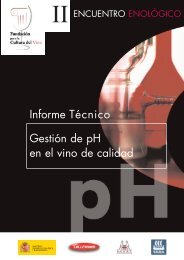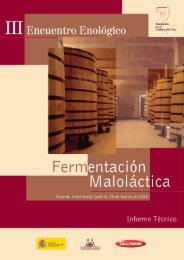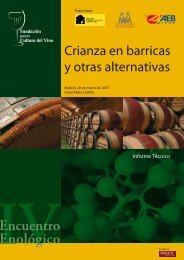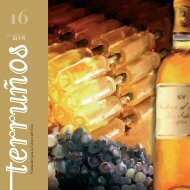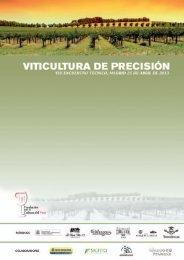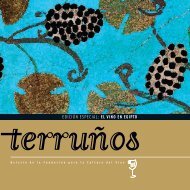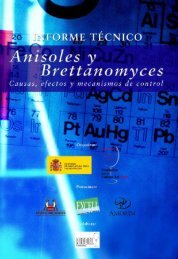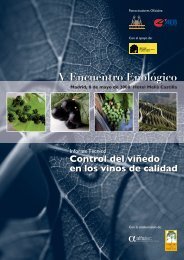Compuestos azufrados volátiles en vinos - Fundación para la ...
Compuestos azufrados volátiles en vinos - Fundación para la ...
Compuestos azufrados volátiles en vinos - Fundación para la ...
You also want an ePaper? Increase the reach of your titles
YUMPU automatically turns print PDFs into web optimized ePapers that Google loves.
Effect of Microoxyg<strong>en</strong>ationon Colorand Anthocyanin-Re<strong>la</strong>ted Compoundsof Wines withDiffer<strong>en</strong>t Ph<strong>en</strong>olicCont<strong>en</strong>tsCano-López, M.; Pardo-Mínguez, F.; Schmauch,G.; Saucier, C.; Teissedre, P.L.; López-Roca, J.M.; andGómez-P<strong>la</strong>za, E.Departam<strong>en</strong>to de Tecnología de Alim<strong>en</strong>tos, Nutricióny Bromatología, Facultad de Veterinaria, Universidadde Murcia, Spain, Bodegas San Isidro, Jumil<strong>la</strong>, Murcia,Spain, and Faculté d’O<strong>en</strong>ologie, Université VictorSegal<strong>en</strong>, Bordeaux 2, FranceSeveral factors may affect the results obtained wh<strong>en</strong>micro-oxyg<strong>en</strong>ation is applied to red wines, the mostimportant being the mom<strong>en</strong>t of application, the dosesof oxyg<strong>en</strong>, and the wine ph<strong>en</strong>olic characteristics.In this study, three red wines, made from Vitis viniferavar. Monastrell (2005 vintage) and with differ<strong>en</strong>t ph<strong>en</strong>oliccharacteristics, were micro-oxyg<strong>en</strong>ated to determineas to how this technique affected the formationof new pigm<strong>en</strong>ts in the wines and their chromaticcharacteristics. The results indicated that the differ<strong>en</strong>twines were differ<strong>en</strong>tly affected by micro-oxyg<strong>en</strong>ation.In g<strong>en</strong>eral, the micro-oxyg<strong>en</strong>ated wines had a higherperc<strong>en</strong>tage of new anthocyanin-derived pigm<strong>en</strong>ts,being that this formation is more favored in the wineswith the highest total ph<strong>en</strong>ol cont<strong>en</strong>t. These compounds,in turn, significantly increased the wine colorint<strong>en</strong>sity. The wine with the lowest ph<strong>en</strong>olic cont<strong>en</strong>twas less influ<strong>en</strong>ced by micro-oxyg<strong>en</strong>ation, and theobserved evolution in the degree of polymerizationof tannins suggested that it might have suffered overoxyg<strong>en</strong>ation.KEYWORDS: Wine; color; anthocyanins; anthocyanin-derivedcompounds; micro-oxyg<strong>en</strong>ation.INTRODUCTIONPh<strong>en</strong>olic compounds are responsible for many of theorganoleptic characteristics of wines. Among them,anthocyanins are responsible for the color of red wine,Seminario Técnico<strong>Compuestos</strong> <strong>azufrados</strong> volátiles <strong>en</strong> <strong>vinos</strong>while their interactions with other compounds <strong>la</strong>rgelydetermine the color changes observed in maturingwines. The wine ph<strong>en</strong>olic cont<strong>en</strong>t dep<strong>en</strong>ds on thegrape characteristics and on the winemaking process.Factors such as ph<strong>en</strong>olic maturity of the grapes, l<strong>en</strong>gthof maceration, frequ<strong>en</strong>cy of pumping over, etc. determinethe final wine ph<strong>en</strong>olic cont<strong>en</strong>t (1–3).The importance of oxyg<strong>en</strong> in the evolution of winecolor has be<strong>en</strong> studied for many years, both as regardsits role in polyph<strong>en</strong>ol oxidation (4–7) and as a promoterof the formation on new anthocyanin-derivedcompounds (5, 8–11). Indeed, one way of manipu<strong>la</strong>tingthe ph<strong>en</strong>olic structure of a wine is to use themicro-oxyg<strong>en</strong>ation (MO) technique, which relies onthe formation of microbubbles through the injectionof gaseous oxyg<strong>en</strong> into the wine using a microdiffuser(12). These bubbles rise through the wine, dissolvingas they travel to the surface.Empirical results have indicated that MO b<strong>en</strong>efits includethe stabilization of wine color, the soft<strong>en</strong>ing oftannins, and the less<strong>en</strong>ing of vegetative aromas (13,14). Reactions involving wine polyph<strong>en</strong>ols are the keyto these processes, which include changes in proanthocyaninchain l<strong>en</strong>gth and the consequ<strong>en</strong>t effect onwine astring<strong>en</strong>cy and the linking of anthocyanins andtannins to form more stably colored forms. Dissolvedoxyg<strong>en</strong> leads to the formation of acetaldehyde that, inturn, reacts with f<strong>la</strong>vanols and anthocyanins to inducethe formation of a very reactive carbocation that quicklyreacts with another f<strong>la</strong>vanol molecule or with anthocyanin,producing ethyl bridge-linked compounds(15, 16). They are unstable (17) and undergo reactionsthat lead to the formation of new compounds suchas f<strong>la</strong>vanyl pyranoanthocyanins. These <strong>en</strong>d productsare more stable and colored than the original compounds(11). Moreover, incorporation of anthocyanininto tannin structures also may lead to a decrease inastring<strong>en</strong>cy (18).Since its commercial adoption, MO has become commonpractice and is now used worldwide, althoughmost of the avai<strong>la</strong>ble information is from empirical results.Only a few sci<strong>en</strong>tific publications can be foundthat are re<strong>la</strong>ted to the effects of MO (8, 19–23). Severalfactors may affect the final results obtained by MO,the most important being the mom<strong>en</strong>t of application,doses of oxyg<strong>en</strong>, and wine characteristics. Wines havemarked differ<strong>en</strong>ces in their respective abilities to consumeoxyg<strong>en</strong>. As a g<strong>en</strong>eral rule, this facility is directlyre<strong>la</strong>ted to their re<strong>la</strong>tive conc<strong>en</strong>tration of polyph<strong>en</strong>olssince ph<strong>en</strong>olic compounds are the main consumersof oxyg<strong>en</strong> (60%) together with ethanol (20%) and SO 2(12%) (22). In our first studies, we tested the use of differ<strong>en</strong>tdoses of oxyg<strong>en</strong> and the effect of the mom<strong>en</strong>tof application on wine chromatic characteristics (23,24). Here, we report the results of a commercial scaleMO experim<strong>en</strong>t where the influ<strong>en</strong>ce of applying oxyg<strong>en</strong>to three wines made from Monastrell grapes ofJ. Agric. Food Chem. 2008, 56, 5932–5941Textos asociados91



